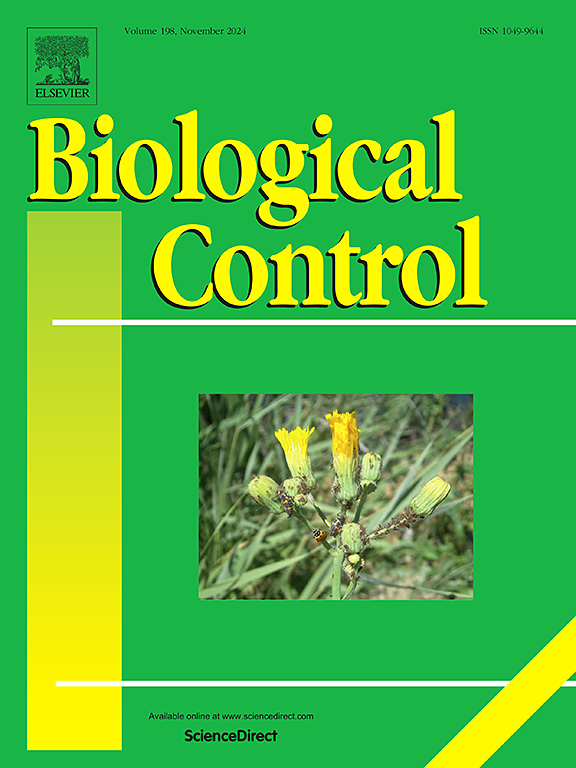Evaluation of antibacterial activity of Bacillus velenesis 21-128 against Xanthomonas campestris pv. Campestris
IF 3.4
2区 农林科学
Q2 BIOTECHNOLOGY & APPLIED MICROBIOLOGY
引用次数: 0
Abstract
Xanthomonas campestris pv. campestris (Xcc) is a gram-negative bacterium that causes black rot, a disease that significantly reduces cruciferous crops yields. Crop production is facing environmental and health challenges associated with the use of synthetic chemicals, highlighting the need for effective biological control agents as sustainable alternatives. In this study, we isolated and characterized the Bacillus velezensis 21–128 strain for antimicrobial activity against Xcc using pot experiments and various enzymatic activity assays. We used ultra-performance liquid chromatography and quadrupole time-of-flight mass spectrometry (UPLC-Q-TOF-MS) analysis to confirm the presence of lipopeptides, including surfactins in the ethyl acetate extract from Bacillus velezensis 21–128. Four types of surfactins—C13, C14, C15, and C16—were identified by mass fragmentation analysis. Further, we used a combination of separation methods, including HP-20 column chromatography, MPLC, and semi-preparative HPLC to isolate and purify the identified surfactins. The purified surfactins were compared with standard substances using HPLC and identified through comparative analysis with LC-MS data. Lastly, we evaluated the antimicrobial activity of the isolated surfactins against the Xcc strain, and determined the minimum inhibitory concentration values for the total surfactin group, G2, G3, G4, and G5. These results suggest that the Bacillus velezensis strain 21–128 could serve as a biological control agent against Xcc and could be a promising strategy against black rot in cruciferous crops.
芽孢杆菌21-128对油菜黄单胞菌的抑菌活性评价。定
油菜黄单胞菌。campestris (Xcc)是一种革兰氏阴性细菌,会导致黑腐病,这种病会显著降低十字花科作物的产量。作物生产正面临与使用合成化学品有关的环境和健康挑战,突出表明需要有效的生物防治剂作为可持续的替代品。本研究通过盆栽实验和各种酶活性测定,分离并鉴定了velezensis 21-128菌株对Xcc的抑菌活性。我们利用超高效液相色谱和四极杆飞行时间质谱(UPLC-Q-TOF-MS)分析证实了velezensis 21-128乙酸乙酯提取物中存在脂肽,包括表面素。通过质量碎片分析鉴定出c13、C14、C15和c16四种表面素。此外,我们采用HP-20柱层析、MPLC和半制备高效液相色谱相结合的分离方法对鉴定的表面素进行分离纯化。用高效液相色谱法将纯化的表面素与标准品进行比较,并与LC-MS数据进行对比分析。最后,我们评估了分离的表面素对Xcc菌株的抑菌活性,并确定了总表面素组、G2、G3、G4和G5的最小抑菌浓度。这些结果表明,velezensis芽孢杆菌菌株21-128可以作为Xcc的生物防治剂,是防治十字花科作物黑腐病的一种有前景的策略。
本文章由计算机程序翻译,如有差异,请以英文原文为准。
求助全文
约1分钟内获得全文
求助全文
来源期刊

Biological Control
生物-昆虫学
CiteScore
7.40
自引率
7.10%
发文量
220
审稿时长
63 days
期刊介绍:
Biological control is an environmentally sound and effective means of reducing or mitigating pests and pest effects through the use of natural enemies. The aim of Biological Control is to promote this science and technology through publication of original research articles and reviews of research and theory. The journal devotes a section to reports on biotechnologies dealing with the elucidation and use of genes or gene products for the enhancement of biological control agents.
The journal encompasses biological control of viral, microbial, nematode, insect, mite, weed, and vertebrate pests in agriculture, aquatic, forest, natural resource, stored product, and urban environments. Biological control of arthropod pests of human and domestic animals is also included. Ecological, molecular, and biotechnological approaches to the understanding of biological control are welcome.
 求助内容:
求助内容: 应助结果提醒方式:
应助结果提醒方式:


